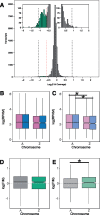Sex-Biased Gene Expression and Dosage Compensation on the Artemia franciscana Z-Chromosome
- PMID: 30865260
- PMCID: PMC6456005
- DOI: 10.1093/gbe/evz053
Sex-Biased Gene Expression and Dosage Compensation on the Artemia franciscana Z-Chromosome
Abstract
Males and females of Artemia franciscana, a crustacean commonly used in the aquarium trade, are highly dimorphic. Sex is determined by a pair of ZW chromosomes, but the nature and extent of differentiation of these chromosomes is unknown. Here, we characterize the Z chromosome by detecting genomic regions that show lower genomic coverage in female than in male samples, and regions that harbor an excess of female-specific SNPs. We detect many Z-specific genes, which no longer have homologs on the W, but also Z-linked genes that appear to have diverged very recently from their existing W-linked homolog. We assess patterns of male and female expression in two tissues with extensive morphological dimorphism, gonads, and heads. In agreement with their morphology, sex-biased expression is common in both tissues. Interestingly, the Z chromosome is not enriched for sex-biased genes, and seems to in fact have a mechanism of dosage compensation that leads to equal expression in males and in females. Both of these patterns are contrary to most ZW systems studied so far, making A. franciscana an excellent model for investigating the interplay between the evolution of sexual dimorphism and dosage compensation, as well as Z chromosome evolution in general.
Keywords: crustacean; dosage compensation; gene expression; sex chromosome; sexual dimorphism.
© The Author(s) 2019. Published by Oxford University Press on behalf of the Society for Molecular Biology and Evolution.
Figures




Similar articles
-
Chromosome-Level Assembly of Artemia franciscana Sheds Light on Sex Chromosome Differentiation.Genome Biol Evol. 2024 Jan 5;16(1):evae006. doi: 10.1093/gbe/evae006. Genome Biol Evol. 2024. PMID: 38245839 Free PMC article.
-
Chromatin Landscape Is Associated With Sex-Biased Expression and Drosophila-Like Dosage Compensation of the Z Chromosome in Artemia franciscana.Mol Biol Evol. 2025 Apr 30;42(5):msaf085. doi: 10.1093/molbev/msaf085. Mol Biol Evol. 2025. PMID: 40202086 Free PMC article.
-
Global Dosage Compensation Is Ubiquitous in Lepidoptera, but Counteracted by the Masculinization of the Z Chromosome.Mol Biol Evol. 2017 Oct 1;34(10):2637-2649. doi: 10.1093/molbev/msx190. Mol Biol Evol. 2017. PMID: 28957502 Free PMC article.
-
Sex determination and gonadal sex differentiation in the chicken model.Int J Dev Biol. 2018;62(1-2-3):153-166. doi: 10.1387/ijdb.170319cs. Int J Dev Biol. 2018. PMID: 29616724 Review.
-
Sex-Biased Gene Expression.Annu Rev Genet. 2016 Nov 23;50:29-44. doi: 10.1146/annurev-genet-120215-035429. Epub 2016 Aug 26. Annu Rev Genet. 2016. PMID: 27574843 Review.
Cited by
-
Chromosome-Level Assembly of Artemia franciscana Sheds Light on Sex Chromosome Differentiation.Genome Biol Evol. 2024 Jan 5;16(1):evae006. doi: 10.1093/gbe/evae006. Genome Biol Evol. 2024. PMID: 38245839 Free PMC article.
-
Chromatin accessibility, not 5mC methylation covaries with partial dosage compensation in crows.PLoS Genet. 2023 Sep 25;19(9):e1010901. doi: 10.1371/journal.pgen.1010901. eCollection 2023 Sep. PLoS Genet. 2023. PMID: 37747941 Free PMC article.
-
Transitions to asexuality and evolution of gene expression in Artemia brine shrimp.Proc Biol Sci. 2021 Sep 29;288(1959):20211720. doi: 10.1098/rspb.2021.1720. Epub 2021 Sep 22. Proc Biol Sci. 2021. PMID: 34547909 Free PMC article.
-
High-quality chromosome-level genome assembly of female Artemia franciscana reveals sex chromosome and Hox gene organization.Heliyon. 2024 Sep 28;10(19):e38687. doi: 10.1016/j.heliyon.2024.e38687. eCollection 2024 Oct 15. Heliyon. 2024. PMID: 39435060 Free PMC article.
-
Evaluation of four methods to identify the homozygotic sex chromosome in small populations.BMC Genomics. 2022 Feb 24;23(1):160. doi: 10.1186/s12864-022-08393-z. BMC Genomics. 2022. PMID: 35209843 Free PMC article.
References
-
- Accioly IV, da Cunha IMC, Tavares JCM, Molina WF.. 2015. Chromosome banding in Crustacea. I. Karyotype, Ag-NORs, C banding and treatment with EcoRI, PstI and KpnI restriction endonucleases in Artemia franciscana. Biota Amazônia v.4. 4(2):15–19.
-
- Andrews S. 2010. FastQC: a quality control tool for high throughput sequence data [Online]. Available from: http://www.bioinformatics.babraham.ac.uk/projects/fastqc/.
Publication types
MeSH terms
LinkOut - more resources
Full Text Sources

